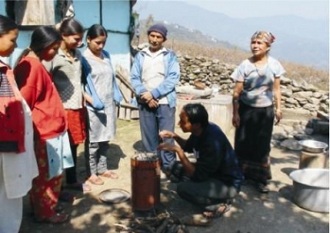Substantial action is required to limit the increase of global average temperature to less than 2 degrees C
Major greenhouse gas-emitting countries agreed in December climate talks held in Copenhagen that substantial action is required to limit the increase of global average temperature to less than 2 degrees C (3.6 degrees F). In a paper appearing May 3 in the Proceedings of the National Academy of Sciences (PNAS), Veerabhadran Ramanathan and Yangyang Xu, climate researchers at Scripps Institution of Oceanography, UC San Diego, have identified three avenues by which those countries can avoid reaching the warming threshold, a point beyond which many scientists believe climate change will present unmanageable negative consequences for society. “Without an integrated approach that combines CO2 emission reductions with reductions in other climate warmers and climate-neutral air-pollution laws, we are certain to pass the 2-degree C and likely reach a 4 degree C threshold during this century,” said Ramanathan.
“Fortunately there is still time to avert unmanageable climate changes, but we must act now.” Using a synthesis of National Science Foundation-funded research performed over the last 20 years, Ramanathan and Xu describe three steps that must be taken simultaneously to avoid the threshold, stressing that carbon dioxide control alone is not sufficient.
Recommended steps include stabilizing CO2 concentrations in the atmosphere, and fashioning warming-neutral pollution laws that will balance the removal of aerosols that have an atmospheric cooling effect with the removal of warming agents such as soot and ozone.
Finally, the authors advocate achieving reductions in methane, hydrofluorocarbons and other greenhouse gases that remain in the atmosphere for short periods of time. The authors write that aggressive simultaneous pursuit of these strategies could reduce the probability of reaching the temperature threshold to less than 10 percent before the year 2050. “By taking a comprehensive look at human induced climate change, this paper clearly separates the global actions which must be undertaken simultaneously — and how quickly these actions must be taken,” said Larry Smarr, founding Director of the California Institute for Telecommunications and Information Technology (Calit2) and a collaborator with Ramanathan on CO2 reduction strategies. “This paper should be required reading for all policy makers.”
The 2-degree C global temperature increase limit translates to a radiant energy increase of 2.5 watts per square meter. Ramanathan and Xu note that even if greenhouse gas emissions stop increasing in the next five years, human activities will probably create almost double that much radiant energy, which is compensated partially by the masking effect of certain kinds of aerosols that are produced in large part by pollution. Tiny particles of sulfates and other pollutants serve to cool the atmosphere by reflecting sunlight rather than absorbing it, directing heat away from the earth’s surface.
Therefore, the authors argue, pollution control measures must take into account and counterbalance the warming that will happen when certain types of pollutants are removed from the skies. Ramanathan and Xu acknowledge that there are uncertainties about the nature of aerosols and the sensitivity of climate to mitigation actions that make the effects of their suggested course of action hard to determine with precision. They propose demonstration projects to clarify and reduce the uncertainties and verify the efficacies of the various mitigation avenues proposed in the study. The authors add that trends in energy added to the oceans would respond to mitigation actions even before 2050, making them an important diagnostic tool that can gauge the success of mitigation within 20 years.
Supporters of the so-called Copenhagen Accord agreed that the 2-degree C threshold must not be crossed, but the United Nations-sponsored conference did not produce hoped-for binding targets for greenhouse gas emissions reductions. Scientists have suggested that exceeding that temperature threshold would trigger irreversible phenomena such as widespread release of methane from melting permafrost and large-scale glacial melt, both of which scenarios would exacerbate climate change-related problems such as sea-level rise and acceleration of global warming.
Avoiding the threshold requires holding carbon dioxide levels to less than 441 parts per million, according to the authors, only slightly higher than today’s value of 389 ppm. This equates to a 50-percent reduction in greenhouse gas emissions by 2050 and an 80-percent reduction by 2100. Ramanathan and Xu acknowledge that such drastic reduction will require a “portfolio of actions in the energy, industrial, agricultural and forestry sections.” Some of these actions will require development of new technologies. “A massive decarbonization of the energy sector is necessary to accomplish this Herculean task,” the authors write. But the strategies not focused on CO2 reduction can largely take advantage of existing technologies and more aggressive enforcement of existing regulations.
Actions that can be taken immediately include replacement of biomass-fueled stoves with cleaner alternatives in developing countries and retrofitting of diesel filters on vehicles throughout the world. “The ‘low-hanging fruits’ approach to one of mankind’s great challenges is very appealing because it is a win-win approach,” said Jay Fein, program director in NSF’s Division of Atmospheric and Geospace Sciences, which funds much of Ramanathan’s research.
Source – 7th Space



